-
 Bitcoin
Bitcoin $101,898.5005
-0.75% -
 Ethereum
Ethereum $2,258.1125
-1.07% -
 Tether USDt
Tether USDt $1.0004
0.01% -
 XRP
XRP $2.0178
-2.93% -
 BNB
BNB $624.0243
-1.53% -
 Solana
Solana $134.3298
-0.90% -
 USDC
USDC $0.9999
0.01% -
 TRON
TRON $0.2675
-2.05% -
 Dogecoin
Dogecoin $0.1538
-1.96% -
 Cardano
Cardano $0.5482
-1.11% -
 Hyperliquid
Hyperliquid $35.5636
5.45% -
 Bitcoin Cash
Bitcoin Cash $453.4902
-1.66% -
 Sui
Sui $2.5134
-2.97% -
 UNUS SED LEO
UNUS SED LEO $9.1292
1.77% -
 Chainlink
Chainlink $11.8457
-1.60% -
 Stellar
Stellar $0.2312
-2.73% -
 Avalanche
Avalanche $16.9721
0.29% -
 Toncoin
Toncoin $2.7549
-3.82% -
 Shiba Inu
Shiba Inu $0.0...01081
-1.10% -
 Litecoin
Litecoin $80.8250
-0.71% -
 Hedera
Hedera $0.1374
0.21% -
 Monero
Monero $305.4827
-2.36% -
 Ethena USDe
Ethena USDe $1.0006
0.00% -
 Dai
Dai $1.0000
-0.01% -
 Polkadot
Polkadot $3.2085
-3.12% -
 Bitget Token
Bitget Token $4.0845
-3.13% -
 Uniswap
Uniswap $6.3353
-1.63% -
 Pi
Pi $0.5085
-0.70% -
 Pepe
Pepe $0.0...08913
-3.82% -
 Aave
Aave $232.7090
-0.58%
What does KDJ three-line adhesion represent? How to judge the subsequent trend of this pattern?
KDJ three-line adhesion in crypto trading signals consolidation; watch for breakouts and confirm with volume and other indicators for trend direction.
May 23, 2025 at 07:57 am
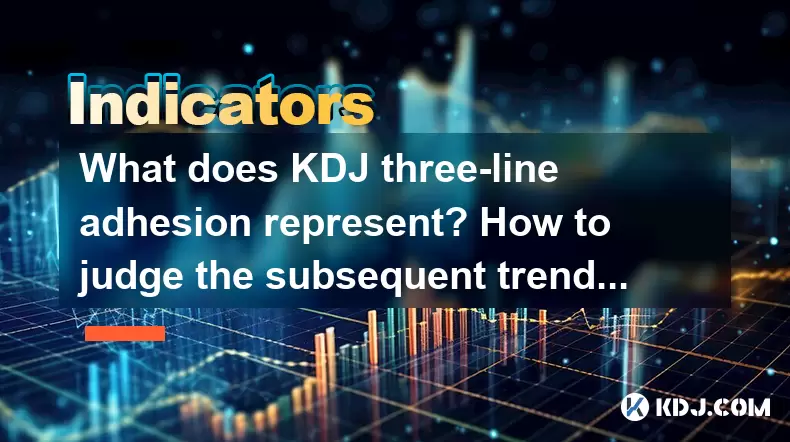
What is KDJ Three-Line Adhesion?
The KDJ three-line adhesion is a technical analysis pattern that occurs when the three lines of the KDJ indicator—namely the K line, D line, and J line—converge and move closely together. The KDJ indicator is a momentum oscillator derived from the Stochastic Oscillator, commonly used in cryptocurrency trading to predict price movements and potential trend reversals.
How Does KDJ Work in Cryptocurrency Trading?
In cryptocurrency trading, the KDJ indicator is used to identify overbought and oversold conditions in the market. The KDJ consists of three lines: the K line, the D line, and the J line. The K line is the fastest line and reflects the current market momentum. The D line is a slower-moving line that smooths out the K line, and the J line is a more sensitive line that can indicate extreme conditions.
- K Line: Represents the fastest-moving line and is calculated based on the highest and lowest prices over a specific period.
- D Line: A smoothed version of the K line, which helps reduce false signals.
- J Line: Derived from the K and D lines, it's used to identify extreme market conditions.
Identifying KDJ Three-Line Adhesion
KDJ three-line adhesion happens when these three lines converge and move closely together, indicating a period of market consolidation or indecision. This pattern often precedes significant price movements, making it crucial for traders to understand how to interpret it.
To identify this pattern, traders should observe the following:
- Look for the convergence: The K, D, and J lines should be moving very close to each other.
- Check the timeframe: This pattern can appear on different timeframes, but it's more significant on longer timeframes like daily or weekly charts.
- Monitor the price action: The price should be trading within a narrow range during the adhesion period.
Judging the Subsequent Trend After KDJ Three-Line Adhesion
Judging the subsequent trend after a KDJ three-line adhesion involves understanding the breakout direction and confirming signals from other technical indicators. Here are the steps to follow:
- Watch for a breakout: After the adhesion, the price will eventually break out of the consolidation range. A breakout above the range suggests a bullish trend, while a breakout below indicates a bearish trend.
- Confirm with volume: Higher trading volume during the breakout can confirm the strength of the new trend.
- Use other indicators: Confirm the breakout direction with other indicators like the Moving Average Convergence Divergence (MACD) or the Relative Strength Index (RSI).
Examples of KDJ Three-Line Adhesion in Cryptocurrency Markets
To illustrate how KDJ three-line adhesion works in real cryptocurrency markets, consider the following examples:
- Bitcoin (BTC): In a recent period, Bitcoin's KDJ lines converged closely on the daily chart. After a few days of adhesion, the price broke out to the upside, signaling a bullish trend. Traders who recognized this pattern and confirmed the breakout with volume and other indicators could have entered long positions for potential profits.
- Ethereum (ETH): Ethereum experienced a similar pattern on the weekly chart. After the adhesion, the price broke out downwards, indicating a bearish trend. Traders who identified this pattern and confirmed the bearish breakout could have entered short positions to capitalize on the subsequent downtrend.
Practical Steps to Trade KDJ Three-Line Adhesion
When trading based on KDJ three-line adhesion, follow these practical steps:
- Identify the pattern: Look for the K, D, and J lines converging closely on your chosen timeframe.
- Set up alerts: Use trading platform alerts to notify you when the lines start to separate or when the price breaks out of the consolidation range.
- Confirm the breakout: Wait for the price to break out of the range and confirm the direction with increased volume and other indicators.
- Enter the trade: If the breakout is bullish, enter a long position. If bearish, enter a short position.
- Set stop-loss and take-profit levels: Place stop-loss orders just below the breakout level for long positions or above for short positions. Set take-profit levels based on your risk-reward ratio and potential price targets.
Common Mistakes to Avoid When Trading KDJ Three-Line Adhesion
Avoiding common mistakes is crucial for successful trading based on KDJ three-line adhesion:
- Ignoring volume: Failing to confirm the breakout with increased volume can lead to false signals.
- Relying solely on KDJ: Using KDJ as the only indicator can be risky. Always confirm signals with other technical indicators.
- Entering trades too early: Waiting for a confirmed breakout is essential to avoid false breakouts and whipsaws.
- Overtrading: Trading every KDJ three-line adhesion pattern without considering the broader market context can lead to unnecessary losses.
Frequently Asked Questions
Q: Can KDJ three-line adhesion be used on all cryptocurrencies?
A: Yes, the KDJ three-line adhesion pattern can be applied to all cryptocurrencies. However, the effectiveness may vary depending on the liquidity and volatility of the specific cryptocurrency. It's essential to test the pattern on different assets and timeframes to understand its reliability in various market conditions.
Q: How long does the KDJ three-line adhesion typically last?
A: The duration of KDJ three-line adhesion can vary widely, from a few days to several weeks, depending on the timeframe and the specific market conditions. On shorter timeframes like hourly charts, the adhesion might last only a few hours, while on daily or weekly charts, it could last much longer.
Q: Are there any specific timeframes that are best for trading KDJ three-line adhesion?
A: While KDJ three-line adhesion can be observed on any timeframe, it's generally more reliable on longer timeframes such as daily or weekly charts. These timeframes tend to filter out short-term noise and provide more significant breakout signals. However, traders should choose timeframes that align with their trading style and risk tolerance.
Q: Can KDJ three-line adhesion be used in conjunction with other trading strategies?
A: Yes, KDJ three-line adhesion can be effectively combined with other trading strategies and indicators. For instance, using trend-following indicators like moving averages or trendlines can help confirm the direction of the breakout. Additionally, incorporating risk management techniques such as position sizing and stop-loss orders can enhance the overall effectiveness of trading based on this pattern.
Disclaimer:info@kdj.com
The information provided is not trading advice. kdj.com does not assume any responsibility for any investments made based on the information provided in this article. Cryptocurrencies are highly volatile and it is highly recommended that you invest with caution after thorough research!
If you believe that the content used on this website infringes your copyright, please contact us immediately (info@kdj.com) and we will delete it promptly.
- Cryptocurrencies, Coingecko, and Trending Tokens: What's Hot Now?
- 2025-06-23 23:05:12
- Bitcoin, Meerkat, and Onchain Engagement: A New Era of Crypto
- 2025-06-23 23:25:12
- Cloud Mining, Bitcoin, and XRP: A 2025 Perspective
- 2025-06-23 23:25:12
- Neo Pepe Coin: Meme Crypto with Explosive Potential?
- 2025-06-23 23:45:12
- FUNToken: Decoding Past Trends and Getting Started in the Gaming Crypto Sphere
- 2025-06-23 22:25:12
- Eyenovia Goes Crypto: A HYPE Treasury and Potential Rebrand
- 2025-06-23 23:45:12
Related knowledge

Is it contradictory that the moving average system is arranged in a bullish pattern but the DMI shows a decline in trend strength?
Jun 23,2025 at 11:43pm
Understanding the Moving Average and DMI RelationshipIn cryptocurrency trading, technical analysis plays a crucial role in identifying potential trends and making informed decisions. Two of the most commonly used indicators are the Moving Average (MA) and the Directional Movement Index (DMI). While both tools aim to provide insight into market direction...

What is the significance of the gap formed by the gap opening not being filled within five days?
Jun 23,2025 at 09:42pm
Understanding Gaps in Cryptocurrency TradingIn the world of cryptocurrency trading, a gap refers to a situation where the price of an asset jumps from one level to another without any trading activity occurring between those two levels. This often happens over weekends or holidays when the market is closed, and significant news or events occur that impa...
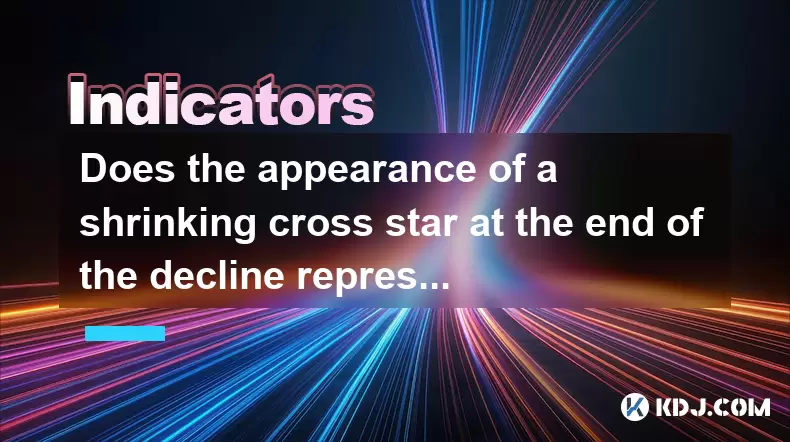
Does the appearance of a shrinking cross star at the end of the decline represent a signal to stop the decline?
Jun 24,2025 at 12:14am
Understanding the Shrinking Cross Star PatternIn the world of cryptocurrency trading, candlestick patterns play a crucial role in technical analysis. One such pattern is the shrinking cross star, which often appears at the end of a downtrend. This pattern consists of a candle with a small body, typically appearing after a series of bearish candles, and ...
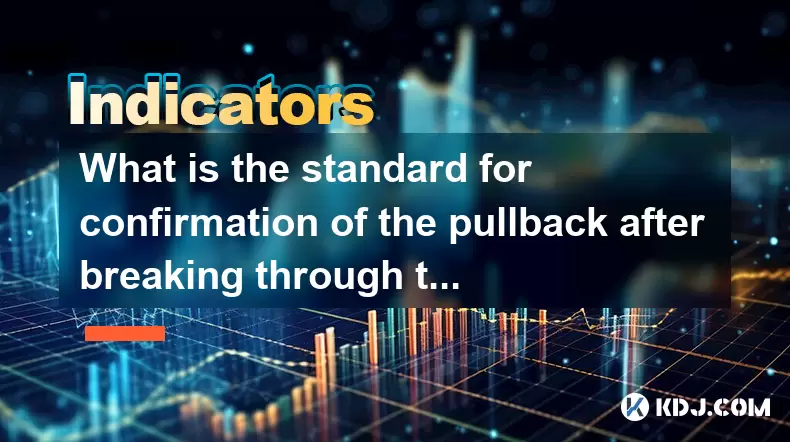
What is the standard for confirmation of the pullback after breaking through the neckline with large volume?
Jun 23,2025 at 11:28pm
Understanding the Neckline in Technical AnalysisIn technical analysis, the neckline is a critical support or resistance level that appears in chart patterns such as head and shoulders, double tops, and double bottoms. It typically connects two or more lows (in the case of a head and shoulders top) or highs (in the case of a head and shoulders bottom). W...
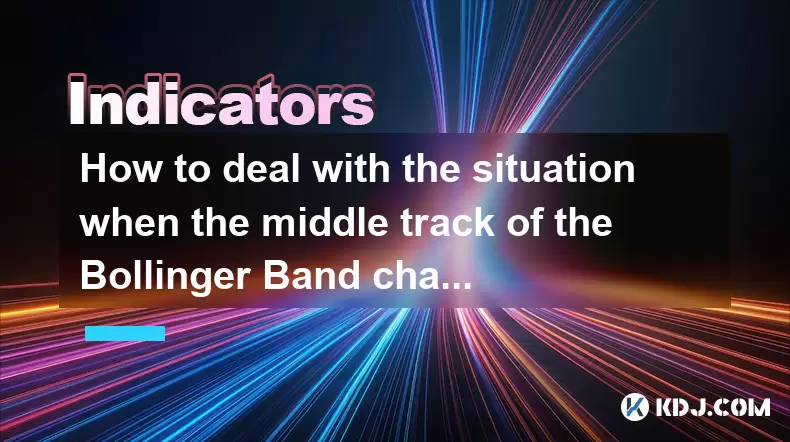
How to deal with the situation when the middle track of the Bollinger Band changes from support to resistance?
Jun 23,2025 at 11:22pm
Understanding the Bollinger Band Middle TrackThe Bollinger Band is a widely used technical indicator in cryptocurrency trading. It consists of three lines: the upper band, the lower band, and the middle track, which is typically a 20-period simple moving average (SMA). Traders often rely on the middle track as a dynamic support or resistance level. Howe...
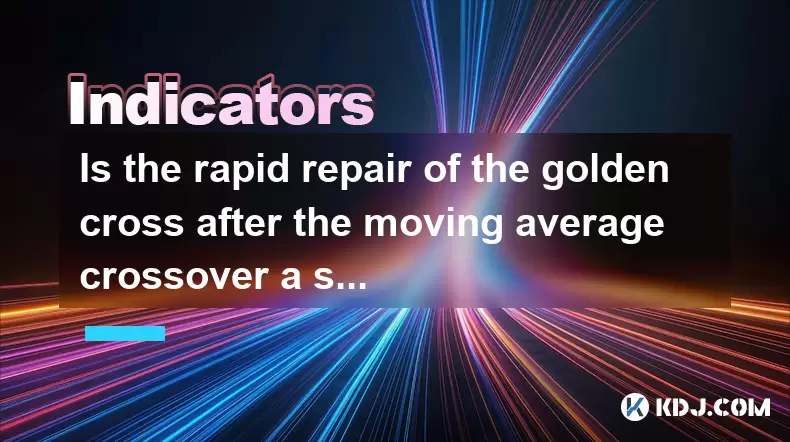
Is the rapid repair of the golden cross after the moving average crossover a signal of inducing short selling?
Jun 24,2025 at 12:01am
Understanding Moving Averages and Their Role in Technical AnalysisIn the realm of technical analysis, moving averages (MAs) are among the most widely used tools by traders to identify trends and potential reversals. These indicators smooth out price data over a specific time period, offering a clearer view of market direction. The two most common types ...

Is it contradictory that the moving average system is arranged in a bullish pattern but the DMI shows a decline in trend strength?
Jun 23,2025 at 11:43pm
Understanding the Moving Average and DMI RelationshipIn cryptocurrency trading, technical analysis plays a crucial role in identifying potential trends and making informed decisions. Two of the most commonly used indicators are the Moving Average (MA) and the Directional Movement Index (DMI). While both tools aim to provide insight into market direction...

What is the significance of the gap formed by the gap opening not being filled within five days?
Jun 23,2025 at 09:42pm
Understanding Gaps in Cryptocurrency TradingIn the world of cryptocurrency trading, a gap refers to a situation where the price of an asset jumps from one level to another without any trading activity occurring between those two levels. This often happens over weekends or holidays when the market is closed, and significant news or events occur that impa...

Does the appearance of a shrinking cross star at the end of the decline represent a signal to stop the decline?
Jun 24,2025 at 12:14am
Understanding the Shrinking Cross Star PatternIn the world of cryptocurrency trading, candlestick patterns play a crucial role in technical analysis. One such pattern is the shrinking cross star, which often appears at the end of a downtrend. This pattern consists of a candle with a small body, typically appearing after a series of bearish candles, and ...

What is the standard for confirmation of the pullback after breaking through the neckline with large volume?
Jun 23,2025 at 11:28pm
Understanding the Neckline in Technical AnalysisIn technical analysis, the neckline is a critical support or resistance level that appears in chart patterns such as head and shoulders, double tops, and double bottoms. It typically connects two or more lows (in the case of a head and shoulders top) or highs (in the case of a head and shoulders bottom). W...

How to deal with the situation when the middle track of the Bollinger Band changes from support to resistance?
Jun 23,2025 at 11:22pm
Understanding the Bollinger Band Middle TrackThe Bollinger Band is a widely used technical indicator in cryptocurrency trading. It consists of three lines: the upper band, the lower band, and the middle track, which is typically a 20-period simple moving average (SMA). Traders often rely on the middle track as a dynamic support or resistance level. Howe...

Is the rapid repair of the golden cross after the moving average crossover a signal of inducing short selling?
Jun 24,2025 at 12:01am
Understanding Moving Averages and Their Role in Technical AnalysisIn the realm of technical analysis, moving averages (MAs) are among the most widely used tools by traders to identify trends and potential reversals. These indicators smooth out price data over a specific time period, offering a clearer view of market direction. The two most common types ...
See all articles
























































































